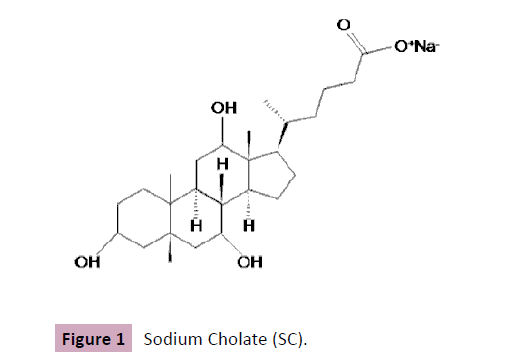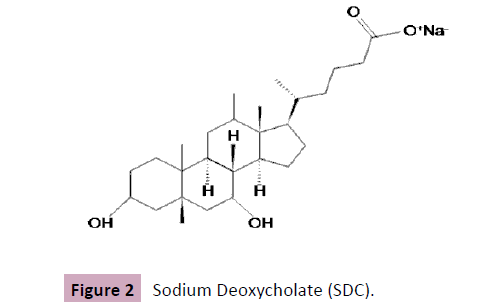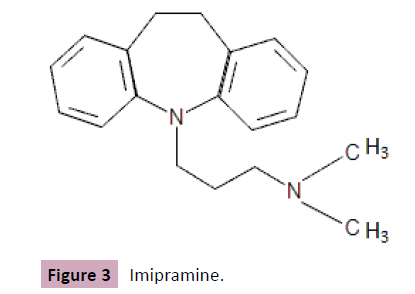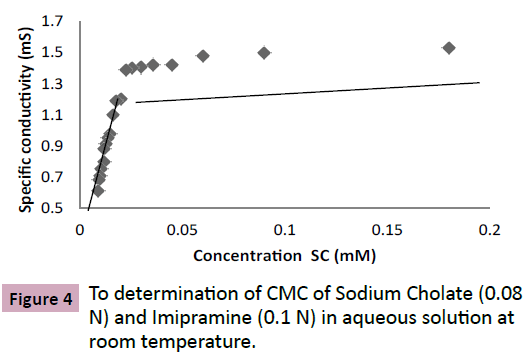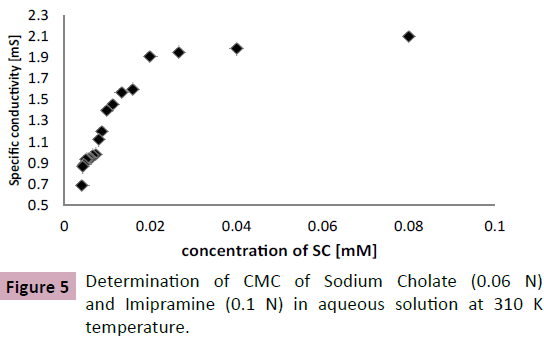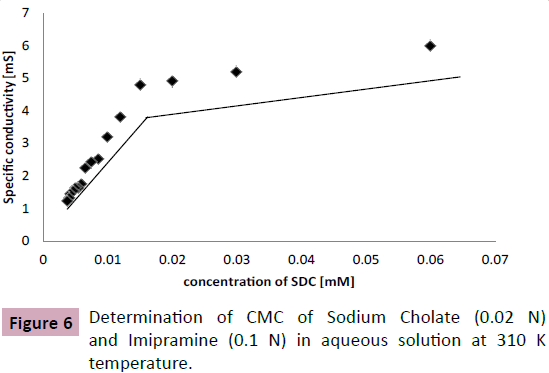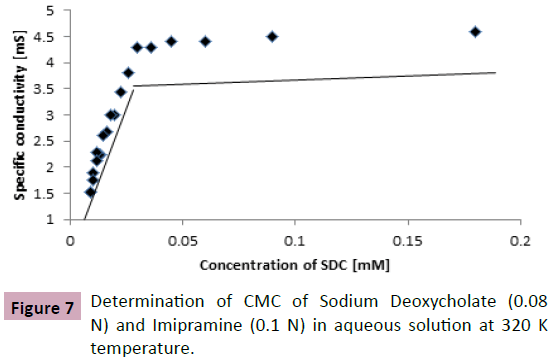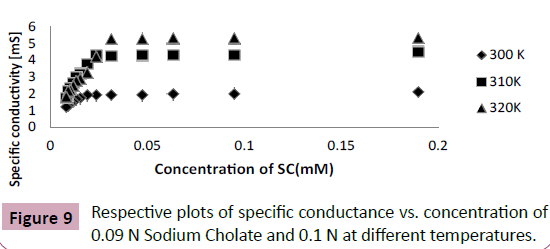Keywords
Antideprassant drug; Sodium Cholate (SC); Sodium Deoxycholate (SDC); Conductometer; Critical micelle concentration; Counter ion dissociation
Introduction
Surfactants word is made up of combination of three different word “surface active agent”. It has two different part- waterloving or hydrophilic and water-hating or hydrophobic. Due to presence of its unique structure it is also known as amphiphilic or amphipathic molecules and due to its nature hydrophilic group of Surfactants forms hydrogen bonds with water molecules, while due to hydrophobic nature hydrocarbon chains aggregate and moving away from the water molecules. Due to these properties surfactants to be soluble in water. In aqueous solutions, they form organized bunch like structures called micelles. Surfactants are further classifies in to various part according to functional group present in it is-Anionic, Cationic, Zwitter ionic, Non-ionic, and Gemini surfactants.
Surfactants play important role in almost every sector of industry like oil recover, pharmaceutical, physical and organic chemistry, cosmetic industry, food science etc. Micelles have importance property in various industries but basically it play important role in pharmaceutical industry because it have ability to dissolve sparingly soluble active substance like drug in aqueous solution. Important role of micelle is in delivery of drug towards targeted area and increase its bioavailability. It also attempt to minimize drug degradation, its loss, and to prevent its harmful side effects [1].
Micelles as drug carriers present some advantages when compared to other alternatives such as soluble polymers and liposomes. Micellar systems can solubilize poorly soluble drugs and thus increase their bioavailability, they can stay in the body (blood) long enough to provide gradual accumulation in the required area, and their sizes permit them to accumulate in areas with leaky vasculature [2].
In general, surfactants play an important role basically in pharmaceutical biotechnology fields, since they are largely utilized in various drug dosage forms to control wetting, stability, bioavailability, among other properties [3]. It is important to notice that lyophobic colloids, such as polymers, require certain energy to be applied for their formation, are quite unstable from the thermodynamic point of view, and frequently form large aggregates. Association colloids such as micelles, on the other hand, can form spontaneously under certain conditions (self-assembling systems), and are thermodynamically more stable towards both dissociation and aggregation [4].
In this work, we provide a review of micellar solubilisation of drugs in surfactant systems, blending it with basic information on surfactants structure and properties, as well as the applications for drug delivery. The main aim of our investigation was to study the influence of varying structures of the hydrophobic regions of selected anionic surfactants on the physico-chemical properties and the synergism effect in the bile salt and -anionic binary systems (Figures 1-3).
Figure 1: Sodium Cholate (SC).
Figure 2: Sodium Deoxycholate (SDC).
Experimental
Material
The bile surfactant Sodium Cholate (SC) and Sodium Deoxycholate (SDC) having anionic nature which is used in experiment was produced from LOBA Chemic and Imipramine. All the solutions were prepared in triple distilled water.
Determination of critical micellization concentration value of binary mixtures
In this experiment micellization tendency is determined by conductometric method because pure water or unionized water is a good insulator of electricity. If any charge or soluble ions present in it then it allow to flow current through aqueous solution thus the amount of current flow is used to calculate its ionic concentration (Tables 1 and 2).
| Concentration of SDC (mm) |
Concentration of Imipramine (mm) |
CMC (mm) |
a |
| 0.1 |
0.1 |
0.016 |
0.0181 |
| 0.09 |
0.1 |
0.0189 |
4.28 × 10-3 |
| 0.08 |
0.1 |
0.022 |
0.166 |
| 0.07 |
0.1 |
0.017 |
0.08 |
| 0.06 |
0.1 |
0.01 |
0.772 |
| 0.05 |
0.1 |
0.0375 |
3.95 × 10-3 |
| 0.04 |
0.1 |
- |
- |
| 0.03 |
0.1 |
0.0216 |
0.077 |
| 0.02 |
0.1 |
0.0075 |
1.7 |
| 0.01 |
0.1 |
0.00423 |
0.0272 |
Table 1: Experimentally obtained critical micelle concentrations of the Sodium Deoxycholate with Imipramine in various concentrations.
| Concentration of SC (mm) |
Concentration of Imipramine (mm) |
CMC (mm) |
a |
| 0.1 |
0.1 |
0.0166 |
0.0266 |
| 0.09 |
0.1 |
0.019 |
0.136 |
| 0.08 |
0.1 |
0.0225 |
0.031 |
| 0.07 |
0.1 |
0.0283 |
0.09 |
| 0.06 |
0.1 |
0.0133 |
0.225 |
| 0.05 |
0.1 |
0.0107 |
0.088 |
| 0.04 |
0.1 |
- |
- |
| 0.03 |
0.1 |
0.0092 |
0.109 |
| 0.02 |
0.1 |
0.01 |
0.148 |
| 0.01 |
0.1 |
0.00916 |
0.116 |
Table 2: Experimentally obtained critical micelle concentrations of the Sodium Cholate with Imipramine in various concentrations at room temperature.
The Critical Micelle Concentration (CMC) of the binary mixtures (Bile salt and Drugs) were studied using conductivity measurements, at different mole fractions and different temperature [5] prepared mixtures consisted of 0.1-1 mole fractions of SC and SDC and 0.1 mole fraction of Imipramine (Figures 4-9).
Figure 4: To determination of CMC of Sodium Cholate (0.08 N) and Imipramine (0.1 N) in aqueous solution at room temperature.
Figure 5: Determination of CMC of Sodium Cholate (0.06 N) and Imipramine (0.1 N) in aqueous solution at 310 K temperature.
Figure 6: Determination of CMC of Sodium Cholate (0.02 N) and Imipramine (0.1 N) in aqueous solution at 310 K temperature.
Figure 7: Determination of CMC of Sodium Deoxycholate (0.08 N) and Imipramine (0.1 N) in aqueous solution at 320 K temperature.
Figure 8: Respective plot of specific conductivity and concentration of 0.08 mM Imipramine at various temperatures.
Figure 9: Respective plots of specific conductance vs. concentration of 0.09 N Sodium Cholate and 0.1 N at different temperatures.
The CMC values for individual non-ionic surfactants and Imipramine were obtained through conductometric measurements (Table 3).
| Surfactants |
SC |
SDC |
Imipramine |
| cmcex/mm |
12 |
6 |
0.00909 |
Table 3: Experimental critical micelle concentration of the individual surfactants.
Effect of drugs on the micellization process of bile salts
Thermodynamics of micellization
Surfactant concentration is increases gradually after some time it reaches at particular concentration which shows deviation between pre micellar region and post micellar region known as CMC, from where micelle form is spontaneous. This means the free energy of surfactants molecule of micelle is always be less than the monomeric surfactants molecule when dissolving in distilled water. All the thermodynamics parameters are temperature dependent [6].
The Gibbs free energy of micellization ΔGm was calculated by using following equation-

The Calculated value of parameter is shown in Tables 4 and 5 at various temperature range. The ΔGm is decrease with increasing temperature, this value show that the micellization process is spontaneous in aqueous mixtures and magnitude of hydrophobic effect is increases with increasing temperature (Tables 4 and 5) [6].
| SDC+Imipramine concentration |
Temperature (Kelvin) |
| SDC (mm) |
Imipramine (mm) |
300 |
310 |
320 |
| CMC (mm) |
a |
CMC |
α |
CMC |
a |
| 0.1 |
0.1 |
0.0166 |
0.0181 |
0.0181 |
0.27 |
0.02 |
0.266 |
| 0.09 |
0.1 |
0.019 |
4.28 × 10-3 |
0.023 |
0.03 |
0.0316 |
3.17 × 10-3 |
| 0.08 |
0.1 |
0.0225 |
0.166 |
0.018 |
0.028 |
0.03 |
0.032 |
| 0.07 |
0.1 |
0.017 |
0.08 |
0.021 |
0.028 |
0.024 |
2.9 × 10-3 |
| 0.06 |
0.1 |
0.01 |
0.772 |
0.0114 |
9.01 × 10-3 |
0.016 |
0.14 |
| 0.05 |
0.1 |
0.0375 |
3.95 × 10-3 |
0.0093 |
4 × 10-3 |
0.0125 |
0.016 |
| 0.04 |
0.1 |
- |
- |
- |
- |
- |
- |
| 0.03 |
0.1 |
0.0216 |
0.077 |
0.0081 |
0.025 |
0.0108 |
0.225 |
| 0.02 |
0.1 |
0.0075 |
0.148 |
0.015 |
0.074 |
0.02 |
0.0238 |
| 0.01 |
0.1 |
0.00423 |
0.116 |
0.0045 |
6.81 × 10-3 |
0.0061 |
0.01 |
Table 4: Critical micelle concentration and α value of various concentrations of Sodium Deoxycholate (SDC) and Imipramine at different temperatures.
| SC+Imipramine concentration |
Temperature (Kelvin) |
| SC (mm) |
Imipramine (mm) |
300 |
310 |
320 |
| CMC |
α |
CMC |
α |
CMC |
a |
| 0.1 |
0.1 |
0.0166 |
0.0266 |
0.022 |
0.16 |
0.04 |
0.011 |
| 0.09 |
0.1 |
0.019 |
0.136 |
0.0316 |
0.05 |
0.047 |
0.082 |
| 0.08 |
0.1 |
0.0225 |
0.031 |
0.03 |
0.041 |
0.045 |
0.133 |
| 0.07 |
0.1 |
0.0283 |
0.09 |
0.0425 |
0.081 |
0.056 |
0.265 |
| 0.06 |
0.1 |
0.0133 |
0.225 |
0.02 |
0.437 |
0.04 |
0.015 |
| 0.05 |
0.1 |
0.0107 |
0.088 |
0.015 |
0.047 |
0.025 |
0.015 |
| 0.04 |
0.1 |
- |
- |
0.0125 |
0.148 |
- |
- |
| 0.03 |
0.1 |
0.0092 |
0.109 |
0.0108 |
0.06 |
0.0162 |
0.153 |
| 0.02 |
0.1 |
0.01 |
0.148 |
0.01 |
0.176 |
0.015 |
0.173 |
| 0.01 |
0.1 |
0.00916 |
0.116 |
0.0078 |
0.227 |
0.011 |
0.028 |
Table 5: Critical micelle concentration and α value of various concentrations of Sodium Cholate (SC) and Imipramine at different temperatures.
The ΔHm can be derived by the Von’t Hoff equation.

The result also shows that standard enthalpy of micellization is negative which indicates that the micelle formation process is exothermic which show strong interaction between drug and bile salts [6].
The ΔSᵒm was determined from the calculated values of ΔGm and ΔHm by the help of following relationship

The ΔSᵒm is always being positive which indicate that the process of micellization is entropy dominated over the micelle formation process. The positive value of ΔSᵒm is due to the hydrophobic interaction between the surfactants and water molecule [6,7].
Development of model
The present study provides an insight into the mechanism of interaction of bile salts with various drugs like Imipramine. Based on the experimental findings it is possible to propose the concentration ranges involved with different stages of changes in the solubilisation of drugs by SC and SDC. The experiments showed that the concentration of a bile salt needed to bring about a certain change in the drugs is strongly dependent on the absolute concentrations of bile salt and not on their molar ratio. The bioavailability of orally administered drugs can be influenced by interacting with food constituent and by physico-chemical conditions in the upper gastrointestinal tract. Normally, bile salts enhance the transport of lipophilic drugs across mucosal membranes. Bile salts are able to form stable mixed micelles consisting of fatty acids and phospholipids. Conventional micellar systems are known to solubilize lipophilic drugs having a low bioavailability [8].
Surfactant (bile salt) added in the drug and distilled water solution, and then the dissolution rate of the Imipramine tablets increases (Tables 1 and 2). It concludes that even presence of small concentration of bile salts is very helpful for the dissolution of various drugs [9].
In method to observing the influence of the structure of drug on formation of mixed micelles [5] with SDC and SC, physico-chemical values of micelles and mixed micelle were calculated by using experimental CMC values which is shown in Tables 4 and 5. cmcid, xid, X1 and the β parameter all were calculated by using following equation [1,7]. The cmcid parameter indicates non-ideal behaviour if it differs from cmcex. The values of xid and the x1 are used to calculate the β parameter. Critical micelle concentrations according to Clint’s theory of ideal mixtures (cmcid) in Tables 6 and 7.
| SDC+Imipramine (300K) |
SDC+Imipramine (310K) |
SDC+Imipramine (320K) |
| CMC |
ΔGm
(kJ/mole) |
ΔHm
(kJ/mole) |
ΔSm
(kJ/mole) |
CMC |
ΔGm
(kJ/mole) |
ΔHm
(kJ/mole) |
ΔSm
(kJ/mole) |
CMC |
ΔGm
(kJ/mole) |
ΔHm
(kJ/mole) |
ΔSm
(kJ/mole) |
| 0.0166 |
-74.26 |
-13.81 |
201 |
0.0181 |
-66.33 |
-12.82 |
255 |
0.02 |
-68.45 |
-13.75 |
170 |
| 0.019 |
-74.11 |
-37.98 |
120 |
0.023 |
-75.5 |
-40.03 |
114 |
0.0316 |
-76.39 |
-43.24 |
103 |
| 0.0225 |
-67.33 |
-19.73 |
158 |
0.018 |
-75.94 |
-22.66 |
171 |
0.03 |
-75.56 |
-24.09 |
160 |
| 0.017 |
-71.83 |
-25.36 |
131 |
0.021 |
-75.11 |
-27.81 |
152 |
0.024 |
-77.82 |
-30.02 |
149.3 |
| 0.01 |
-47.64 |
-21.59 |
86.83 |
0.0114 |
-79.02 |
-37.38 |
134 |
0.016 |
-74.52 |
-37.21 |
116 |
| 0.0375 |
-70.74 |
82 |
509 |
0.0093 |
-80.23 |
87.59 |
541 |
0.0125 |
-80.7 |
92.75 |
542 |
| - |
- |
- |
- |
- |
- |
- |
- |
- |
- |
- |
- |
| 0.0216 |
-70.79 |
49.87 |
402 |
0.0081 |
-80.08 |
53.25 |
430 |
0.0108 |
-72.97 |
52.37 |
391 |
| 0.0075 |
-11.83 |
-11 |
2.76 |
0.015 |
-75.08 |
-75.46 |
-1.2 |
0.02 |
-78.01 |
-82.5 |
-14.03 |
| 0.00423 |
-80.65 |
-2.71 |
259 |
0.0045 |
-83.79 |
-2.92 |
260 |
0.0061 |
-84.83 |
-3.11 |
255 |
Table 6: Thermodynamic parameters for the micellization of various concentration of Sodium Deoxycholate (SDC) with Imipramine.
| SC+Imipramine (300K) |
SC+Imipramine (310K) |
SC+Imipramine (320K) |
| CMC |
ΔGm
(kJ/mole) |
ΔHm
(kJ/mole) |
ΔSm
(kJ/mole) |
CMC |
ΔGm
(kJ/mole) |
ΔHm
(kJ/mole) |
ΔSm
(kJ/mole) |
CMC |
ΔGm
(kJ/mole) |
ΔHm
(kJ/mole) |
ΔSm
(kJ/mole) |
| 0.0166 |
-73.94 |
-64.93 |
30.03 |
0.022 |
-69.91 |
-64.64 |
17 |
0.04 |
-74.85 |
-74.46 |
1.21 |
| 0.019 |
-69.22 |
-63.9 |
17.73 |
0.0316 |
-72.27 |
-71.37 |
2.9 |
0.047 |
-71.29 |
-74.81 |
-11 |
| 0.0225 |
-72.29 |
-51.06 |
70.76 |
0.03 |
-71.94 |
-54.24 |
57.09 |
0.045 |
-69.67 |
-55.08 |
45.5 |
| 0.0283 |
-69.03 |
-49.53 |
65 |
0.0425 |
-69.65 |
-53.13 |
396 |
0.056 |
-53.06 |
-51.19 |
5.84 |
| 0.0133 |
-67.49 |
-73.12 |
-18.76 |
0.02 |
-59.77 |
-68.75 |
-28.96 |
0.04 |
-74.68 |
-93.03 |
-57.31 |
| 0.0107 |
-73.74 |
-60.7 |
43.46 |
0.015 |
-78.57 |
-66.20 |
39.9 |
0.025 |
-77.16 |
-71.68 |
17.12 |
| - |
- |
- |
- |
0.0125 |
-73.06 |
- |
- |
- |
- |
- |
- |
| 0.00928 |
-73.60 |
-39.41 |
113 |
0.0108 |
-77.27 |
-43.17 |
388 |
0.0162 |
-73.94 |
-43.8 |
-94.1 |
| 0.01 |
-71.74 |
-28.09 |
145 |
0.01 |
-73.01 |
-29.54 |
330 |
0.015 |
-73.52 |
-31.53 |
131 |
| 0.00916 |
-73.39 |
-12.9 |
201 |
0.0078 |
-72.01 |
150 |
716 |
0.011 |
-80.97 |
-15.36 |
205 |
Table 7: Thermodynamic parameters for the micellization of various concentration of Sodium Cholate with Imipramine.

The cmcid values are presented and compared to the experimental CMC (cmcex) in Tables 8 and 9 [7]. Deviation of the experimentally obtained CMC values from those calculated according to Clint’s theory indicates non-ideal behaviour of examined surfactant mixtures and mutual interactions of the surfactants in the micelles. according to this experimental CMC are always be smaller than those predicted using models. The mole fraction of the more hydrophobic surfactant in the ideal mixed micelle (xid), according to Motomura [10,11] was calculated using the following relationship:

| Imipramine+SDC |
| α |
cmcid/mm |
cmcex/mm |
Xid |
X1 |
β |
| 0.0181 |
9.25 × 10-3 |
0.0166 |
2.79 × 10-5 |
0.036 |
-7.07 |
| 4.28 × 10-3 |
9.13 × 10-3 |
0.019 |
6.51 × 10-6 |
0.274 |
-18.8 |
| 0.166 |
0.01 |
0.0225 |
3.01 × 10-4 |
0.081 |
-5.764 |
| 0.08 |
9.87 × 10-3 |
0.017 |
1.31 × 10-4 |
0.041 |
-5.65 |
| 0.772 |
0.039 |
0.01 |
5.1 × 10-3 |
-0.543 |
-28.94 |
| 3.95 × 10-3 |
9.09 × 10-3 |
0.0375 |
6 × 10-6 |
0.356 |
-23.09 |
| - |
- |
- |
- |
- |
- |
| 0.077 |
9.84 × 10-3 |
0.0216 |
1.26 × 10-4 |
0.0796 |
-6.68 |
| 1.7 |
-0.013 |
0.0075 |
-3.69 × 10-3 |
0.409 |
-15.05 |
| 0.0272 |
9.35 × 10-3 |
0.00423 |
41.23 × 10-5 |
-0.129 |
-11.61 |
Table 8: Value of cmcid/mM, cmcex/mM, Xid and X1 and the β of the mixed micelles of Imipramine and anionic surfactants (SDC) at different mole fractions in aqueous solution.
| Imipramine+SC |
| α |
cmcid/mm |
cmcex/mm |
Xid |
X1 |
β |
| 0.0266 |
9.33× 10-5 |
0.0166 |
2.06 × 10-5 |
0.034 |
-7.32 |
| 0.136 |
0.0105 |
0.019 |
1.19 × 10-4 |
0.048 |
-5.98 |
| 0.031 |
9.38× 10-5 |
0.0225 |
2.42 × 10-5 |
0.073 |
-8.32 |
| 0.09 |
9.98× 10-5 |
0.0283 |
7.49 × 10-5 |
0.109 |
-7.86 |
| 0.225 |
0.0117 |
0.0133 |
2.19 × 10-4 |
0.159 |
-9.13 |
| 0.088 |
9.96× 10-5 |
0.0107 |
7.30 × 10-5 |
0.106 |
-9.01 |
| - |
- |
- |
- |
- |
- |
| 0.109 |
0.01 |
0.0092 |
9.26× 10-5 |
0.077 |
-8.01 |
| 0.148 |
0.0106 |
0.01 |
1.31 × 10-4 |
0.078 |
-7.60 |
| 0.116 |
0.0102 |
0.00916 |
9.93 × 10-5 |
0.437 |
-26.8 |
Parameters for thermodynamic micellization: ΔGm: Gibbs free energy of micellization;ΔHm: Standard enthalpy of micelle formation; ΔSm: Standard entropy of micellization; T: Temperature; R: Gas constant; Xcmc: Critical micelle concentration in mole fraction unit; α: Conter ion dissociation Parameters for development of model: cmcid: Concentration of ideal mixtures; cmcex: Experimentally obtained critical micelle concentration; xid: Mole fraction of the more hydrophobic surfactant in the ideal mixed micelle; X1: Mole fraction of the more hydrophobic surfactant in the real mixed micelle; β: Interaction parameter; cmc1: Experimentally obtained cmc of the more hydrophobic (nonionic) surfactant (SDC and SC); cmc2: cmc of Imipramine drug; α: Mole fraction of the more hydrophobic surfactant in the solution; αi: Mole fraction of the more hydrophobic surfactant in the solution
Table 9: Value of cmcid/mM, cmcex/mM, Xid and X1 and the β of the mixed micelles of Imipramine and anionic surfactants (SC) at different mole fractions in aqueous solution.
The x1 value was calculate by using following relation:

The xid and the x1 values for the mixed micelles are presented in Tables 8 and 9. Further according to Rubingh equation [7,12] 1x1 value was used to calculate the β interaction parameter, through the following equation:

β values explain the synergism or antagonism between two surfactants in mixed micelles. Its negative value indicate attractive interactions (synergism) between components of mixed micelles of drug and bile salt, The less negative value means the weaker synergistic interaction while positive values shows antagonistic interactions between surfactants in a mixture. Its value also shows the deviation between experimentally obtained (cmcex) and calculated (cmcid) cmc values [7].
Result and Discussion
Conclusion
Binary combinations of bile salt and antidepressant drug (Imipramine) as well as their tendency to form mixed micelles having CMC's different than ideal conditions, the non ideality is more for the binary mixtures. The binary mixture of both surfactants and drug mixture was analysed by conductometer methods. The results of the study have been analysed using Clint's, Rubingh's, and Motomura's theories for mixed binary systems [13]. The Critical Micelle Concentration (CMC) of the ideal mixed micelle, the mole fraction of the more hydrophobic surfactant in the ideal mixed micelle, the mole fraction of the more hydrophobic surfactant in the real mixed micelle, and the β interaction parameter of the mixed micelles were calculated by using experimental values obtained [5]. It was concluded that increased synergistic interactions can be due to the larger number of hydrophilic groups present in the drug and bile salt.
Acknowledgment
The authors are grateful to Dr. Arun Arora, Principal, Bhilai Institute of Technology, Durg for providing laboratory facilities for this work.
References
- Islam MJ, Choundri MMR, Shahed SMF, Subhan MA (2009) Effect of some biologically important organic compounds on the micellar properties of sodium dodecyl sulphate. Proc Pak Acad Sci 46: 91-95.
- Piret J, Lamontagne J, Bestman-Smith J, Roy S, Gourde P, et al. (2000) In vitroand in vivoevaluations of sodium lauryl sulfate and dextran sulfate as microbicides against herpes simplex and human immunodeficiency viruses. J Clin Microbiol38:110-119.
- Rangel-Yagui CO, Pessoa A Jr, Tavares LC (2005) Micellar solublization of drugs. J Pharm Pharmaceut Sci 147-163.
- Kabir-ud-Din, Rub MA, Naqvi AZ (2011) Aqueous amphiphilic drug (amitriptyline hydrochloride)-bile salt mixtures at different temperatures. Colloids Surf B Biointerfaces 84:285-91.
- Moodssac G, Al-Wardian A, Glenn K, Palepu R (2004) Effects of di-, tri-, and tetraethylene glycols on the thermodynamic and micellar properties of Triton X-100 in water. Can J Chem 82: 1774.
- Paria S (2006) The mixing behavior of n-alkylpyridinium bromide-NP-9 mixed surfactant systems. Colloids andSurfaces A: Physicochemical and Engineering281: 113-118.
- Cirin DM, Posa MM, Krstonošić VS (2011) Interactions between selected bile salts and Triton X-100 or sodium lauryl ether sulphate. Chemistry Central Journal 5:89.
- Charman WN, Porter CJH, Mithani S, Dressman JB (1997) Physicochemical and physiological mechanisms for the effects of food on drug absorption: the role of lipids and pH. J Pharm Sci86: 269-282.
- Siddiqui SA, Razvi N, Khan LG(2005) The effect of surfactant on the dissolution rate of ibuprofen tablets. Int Chern Pharm Med J 2: 213-216.
- Cirin DM, Posa MM, Krstonosic VS, Milanovic MLJ (2012) Conductometric study of Sodium dodecyl sulphate non-ionic Surfactants (Triton X-100, A tween 20, Tween 60, Tween 80 or Tween 85) mixed micellein aqueous solution. Hem Ind 66: 21-28.
- Shalaby MN (2008) Synergistic behavior of binary mixed micellar solution. J Dispersion Sci Technol 29: 447-452.
- Rosen MJ, Zhu BY (1986) Synergism in binary mixtures of surfactant: III. Betaine-containing systems. J Colloid Interface Sci 99: 427-434.
- Khan IA, Khanam AJ, Sheikh MS, Kabir-ud-Din (2011) Influence of ionic and non-ionic hydrotropes on micellar behavior of a cationic gemini surfactant butanediyl-1,4-bis (dimethylcetylammonium bromide). J Colloid Interface 15: 467-73.

